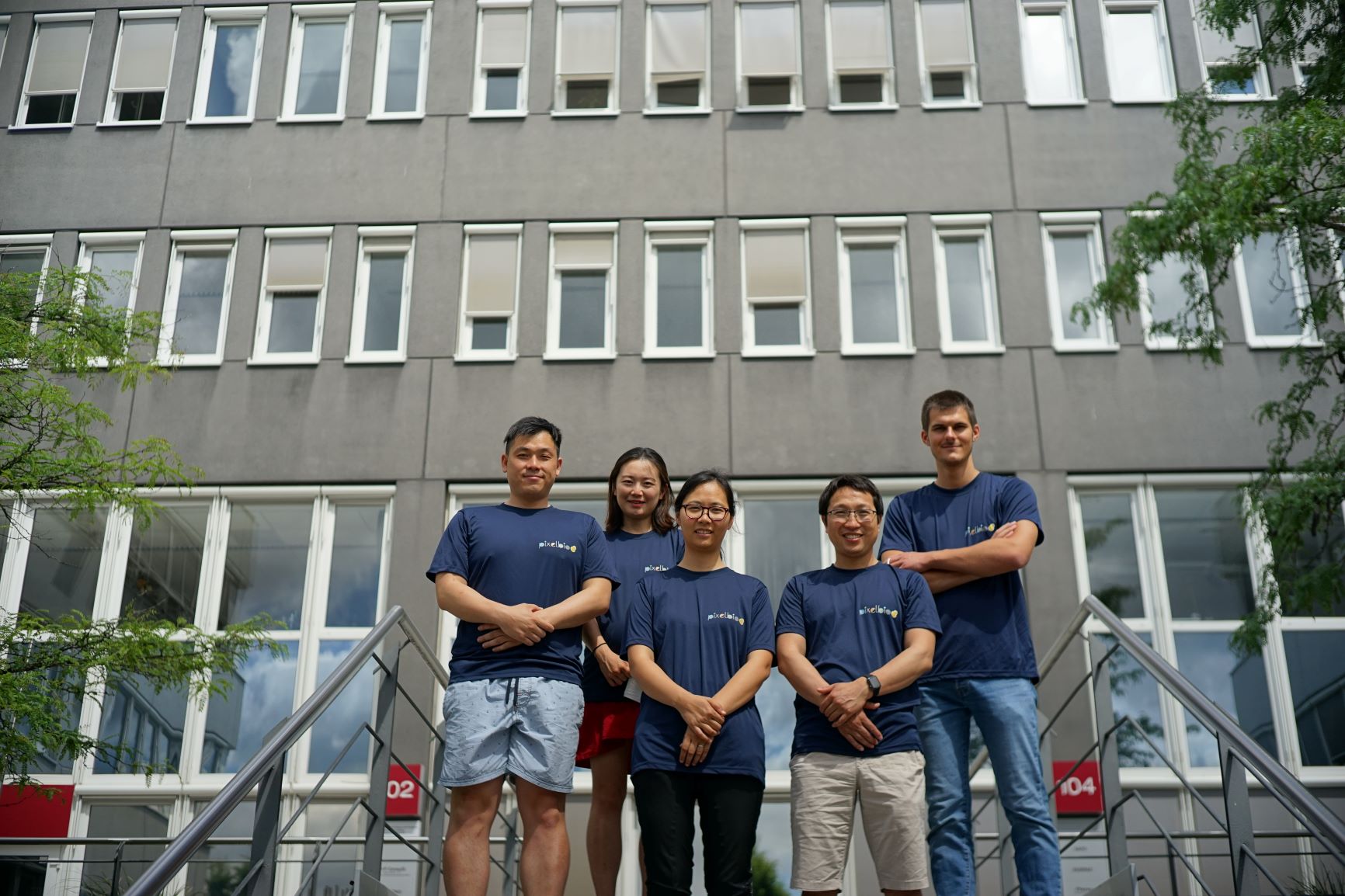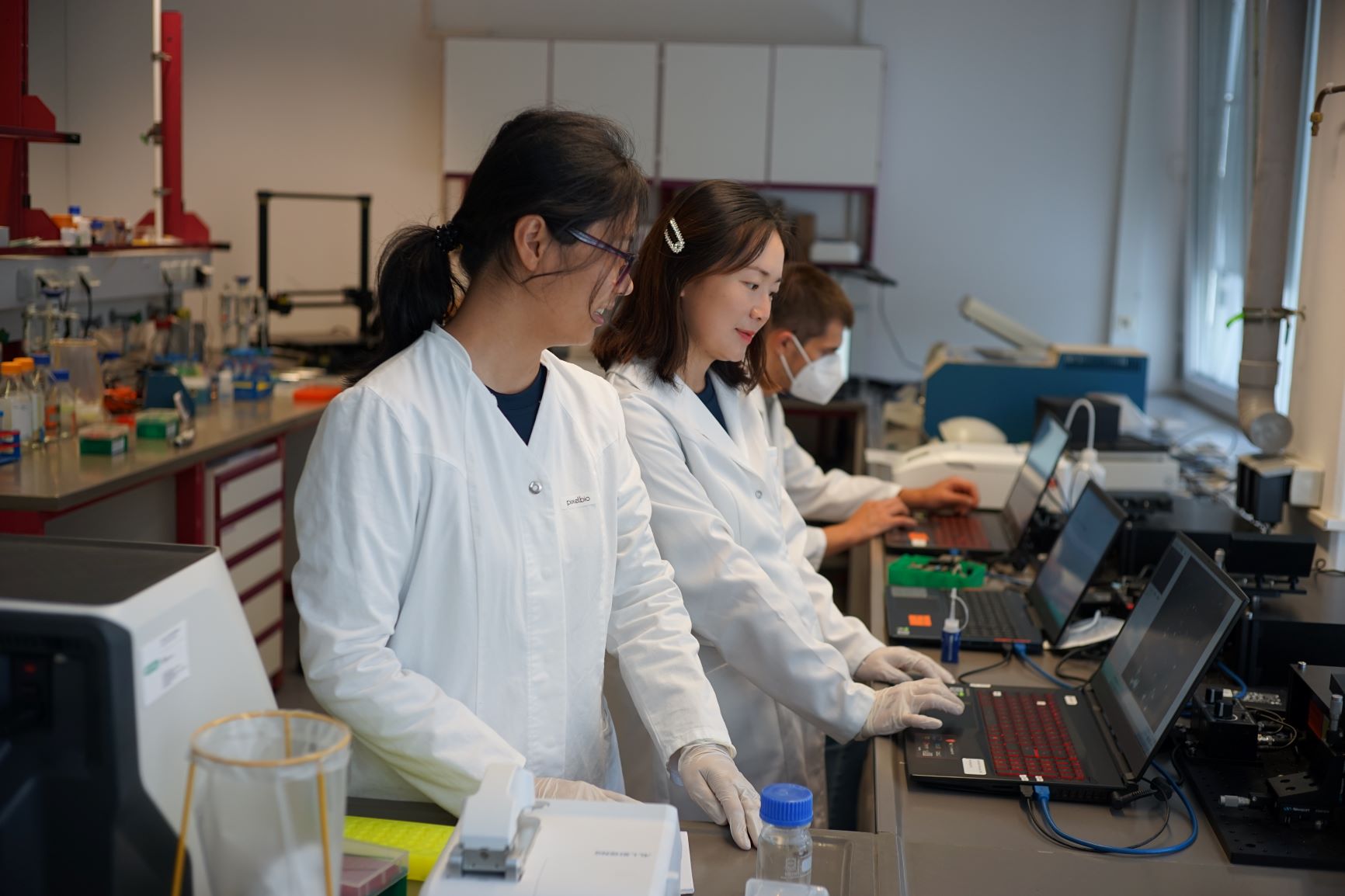PixelBiotech GmbH
Searching for tracks with cytogenetics and AI
The startup Pixelbiotech combines fluorescence techniques with artificial intelligence to detect DNA and RNA in medical samples. HuluFISH is the name of the method, which allows for countless applications - from detecting viral infections, such as COVID-19 or African swine fever virus, to the quality control of gene and immunotherapeutic procedures in cancer medicine.
 CEO Yongsheng Cheng (the second right person) with his team of the PixelBiotech GmbH, which is located at the Heidelberg Technology Park and was founded in 2018 originating from the DKFZ. © PixelBiotech GmbH
CEO Yongsheng Cheng (the second right person) with his team of the PixelBiotech GmbH, which is located at the Heidelberg Technology Park and was founded in 2018 originating from the DKFZ. © PixelBiotech GmbH"It's like counting the stars in the sky." When Yongsheng Cheng talks about the technology behind his company, he goes into raptures. Yongsheng is the CEO of Pixelbiotech GmbH, which was founded in 2018. After studying biology in Beijing, China, he started his PhD at the German Cancer Research Center (DKFZ) in Heidelberg in 2009. During this time, he was already working on the so-called FISH technology, a method for detecting DNA or RNA segments in medical sample material. His startup Pixelbiotech, which he started in 2018 as a spin-off of the DKFZ located at the Heidelberg Technology Park, also applies the FISH technology to detect viruses, bacteria, animal or human cells on the basis of their "genetic fingerprint."
The abbreviation FISH stands for “fluorescence in situ hybridization”. Firstly, a short DNA or RNA segment, which is characteristic for the cell or virus species being searched for, is determined. Secondly, a so-called probe is constructed, targeting this sequence. A probe is a small DNA snippet that complements the gene segment like one puzzle piece fits the other. The probe is labeled with multiple fluorescent dyes (fluorophore). If the gene segment being searched for exists, the labeled probe causes the sample material in an analyzer machine to glow after excitation with light of a specific wavelength. Applying this method, all kinds of carriers of genetic information can be identified - whether viruses, bacteria or, for example, cancer cells.
Different color codes can be analyzed simultaneously
 After excitation with light of a certain wavelength, the Hulu-FISH samples fluoresce colourfully under the microscope, if the right DNA or RNA segments can be detected. © PixelBiotech GmbH
After excitation with light of a certain wavelength, the Hulu-FISH samples fluoresce colourfully under the microscope, if the right DNA or RNA segments can be detected. © PixelBiotech GmbHThe FISH technology itself is not new - it has been around since the 1960s. What is new, however, is the application that PixelBiotech has developed from it. The principle: Different probes are used in combination with different fluorophores to generate a light signal of a specific color depending on the color marker. This allows the analysis to be "multiplexed," meaning that several analyses can be performed simultaneously in a single run. The result is a colorful glowing image with different color pixels, which - as Yongsheng says - resembles a twinkling starry sky. Since it is impossible to capture and count individual pixels with the naked eye, an AI (artificial intelligence) application takes over this task.
Unique combination of molecular biology techniques and AI
It is the unique combination of molecular biology techniques and AI that makes up PixelBiotech's great innovation. This combination is also reflected in the lineup of the founding team: While Yongsheng Cheng brings the molecular biology expertise to the startup, San Francisco-based physicist and computer scientist Xinghua Lou is the AI expert.
 It is the unique combination of molecular biology methods and AI that makes PixelBiotech innovative. © PixelBiotech GmbH
It is the unique combination of molecular biology methods and AI that makes PixelBiotech innovative. © PixelBiotech GmbHPixelBiotech has since grown to eight employees. Last year, the team moved into new premises in Heidelberg Wieblingen, where they are working on further developing the analysis method and its applications.
The simple, fast, and cost-efficient technology allows for countless applications. For example, together with a number of cooperation partners, PixelBiotech has developed a method based on HuluFISH for detecting the African swine fever pathogen. The animal disease is caused by a virus. It cost Chinese farmers several million dollars in 2018 alone and was detected for the first time in wild boar in Germany last year.
The HuluFISH method is also used in clinical quality control, for example to monitor gene expression in human CAR-T cells in selecting the best cell-based immunotherapeutics against cancer. CAR-T stands for "chimeric antigen receptor T-cells," which are genetically engineered immune cells that the immune system recognizes as foreign and fights against.
The coffee machine among FISH analysis systems
In addition to test kits and analysis services, PixelBiotech's portfolio includes the analysis device and the associated AI-based software, that can be used to analyze the fluorescence data. "The test kit with the labeled DNA probe can be inserted into the reader like a coffee pad into a coffee maker," Yongsheng explains. "Our goal is to establish this universal, cost-effective and flexible solution in the market."
On their way to this goal, Yongsheng and his colleagues have already made great strides. Among other things, they were given a “jump-start” by the Life Science Accelerator Baden-Württemberg, through which Pixelbiotech received Start-up BW Preseed funding last year (see also our article "Start-up support for life sciences companies": "Within the Life Science Accelerator, we have the opportunity to further develop our technologies for affordable and precise molecular analyses based on single-molecule RNA in a targeted manner within a secure framework," says Yongsheng. "This makes it possible for us to provide accurate, universal, affordable and accessible gene expression analyses.").
International project on SARS-CoV-2 diagnostics
PixelBiotech is the only European company approved for a National Institutes of Health (NIH) initiative to advance new diagnostic capabilities to combat SARS-CoV-2, which started in early 2021. The initial development phase of this project has already been successfully completed, and validation of the method is following now. "With the HuluFISH technique," Yongsheng explains, "you have an alternative for COVID-19 diagnostics which is 40 times cheaper and 20 times faster than the well-known PCR method."
Note:
This article is a guest contribution written by Dr. Elke Matuschek for Heidelberg Technology Park.
It is published with the kind permission of the author and Heidelberg Technology Park.